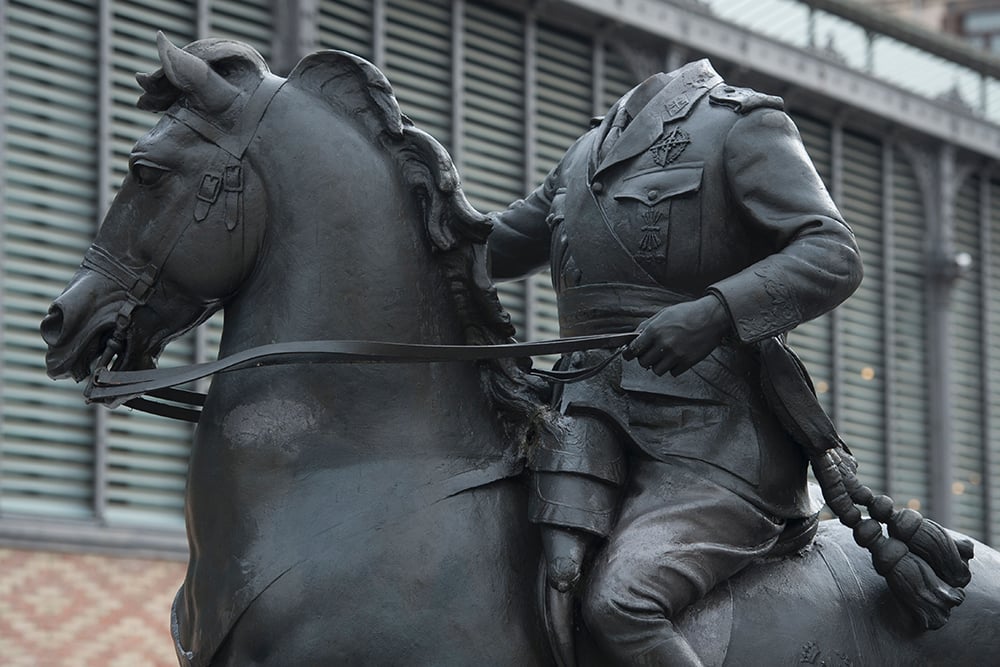
The dictatorship of Francisco Franco is not the proudest chapter of Spain’s history, but the organizers of a new exhibition about the controversial figure probably didn’t expect protesters to hurl eggs at a headless statue of the man during a recent opening—and yet, reports Agence France Presse, that’s exactly what happened in Barcelona on October 17.
The temporary exhibition “Franco, Victory, Republic, Impunity and Urban Space” has brought two Francoist statues, long stored in a Barcelona City Hall warehouse, to the city streets in front of the El Born Centre Cultural.
One, a headless equestrian statue of the dictator by Joan Viladomat, was displayed at Montjuïc Castle from 1963 to 2001. (It has since been decapitated by vandals.) The other is Victoria by Frederic Marés, which featured as a monument on Avinguda Diagonal, one of the city’s main streets, until 2010.
A man is held back as he tries to hit another during the installation of a temporary exhibit titled “Franco, Victory, Republic, Impunity and Urban Space.” Courtesy of Josep Lego/AFP/Getty Images.
In addition to throwing tomatoes and eggs at the works, protesters from a Catalan separatist group gathered to chant “no fascists on our streets,” while a group representing Franco’s victims protested silently. A Catalan flag was also draped across the Viladomat piece. The crowd eventually erupted into violence, with a minor scuffle breaking out between several men.
Barcelona’s deputy mayor, Gerardo Pisarello, told the Catalan News Agency (CNA) in August that the exhibition aims to “force society to think about what Franco’s dictatorship represented,” and to “generate debate.” Though the show claims to denounce Franco’s crimes, not everyone sees it that way.
An Estelada, a Catalan Pro-independence flag, hangs from a headless sculpture of the late Spanish dictator Francisco Franco riding a horse, during the installation of a temporary exhibit titled “Franco, Victory, Republic, Impunity and Urban Space.” Courtesy of Josep Lego/AFP/Getty Images.
“In this country the executioners were not judged and the victims were not properly buried,” Alfred Bosch, president of the Esquerra Republicana de Catalunya, a pro-independence Catalan group, told CNA, saying that the exhibition “gives a sense of normality which doesn’t exist” in Spain.
After Franco died in 1975, the country passed a law granting amnesty for crimes committed during the Civil War and the dictatorial regime that followed. The “Law of Historical Memory,” passed in 2007, but not always enforced, called for the removal of all symbols of Franco’s dictatorship from public buildings.
Meanwhile, in Russia, unrest is brewing ahead of the planned unveiling of a gargantuan statue of the tenth-century figure, Vladimir the Great, who is considered the founder of Russia.
The monument to Vladimir the Great by artist Salavat Shcherbakov is installed in Moscow on October 16, 2016. Courtesy of Vasily Maximov/AFP/Getty Images.
The controversial sculpture by Salavat Shcherbakov, which measures over 52 feet tall, will tower over the Kremlin from its perch just outside the walls on Borovitsky Hill. It is seen as a thinly-veiled monument to Russian president Vladimir Putin, reports the Art Newspaper.
The statue also lends legitimacy to Putin’s annexation of Crimea, Ukraine, as Vladimir the Great, who converted Russia to Orthodox Christianity, was baptized there. The Rb100 million ($1.5 million) piece is being funded by the Military-Historical Society, which was founded by Russian culture minister Vladimir Medinsky.
A picture taken on June 2, 2015 shows Russian sculptor Salavat Shcherbakov looking at a model for a monument to Vladimir the Great at his workshop in Moscow. Courtesy of Vasily Maximov/AFP/Getty Images.
Originally, the government had planned to erect an even taller version, measuring 79 feet tall, at Moscow’s Sparrow Hill. This plan was criticized as environmental hazard that might trigger a landslide, and by those who believed the monumental work would ruin the spot’s scenic vistas.